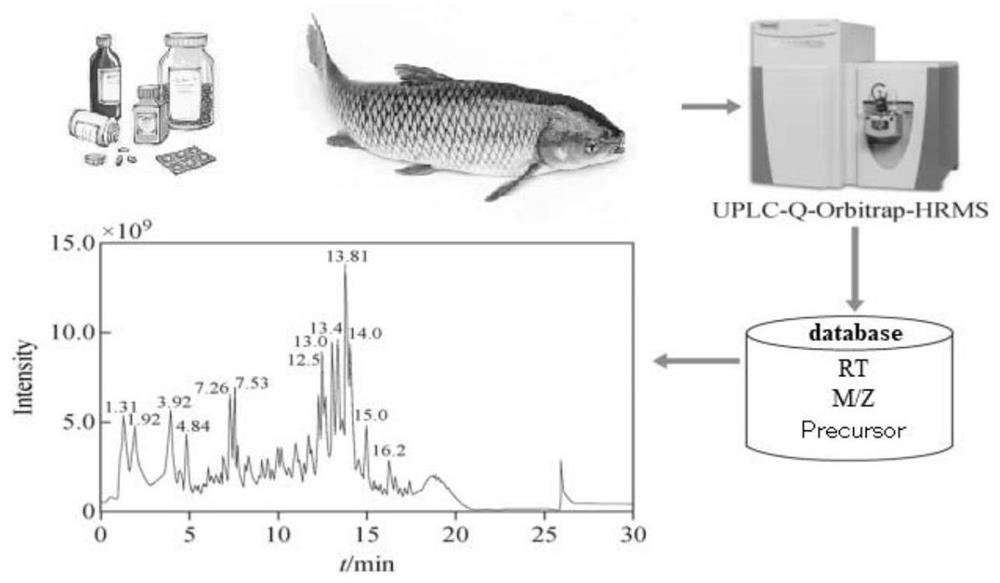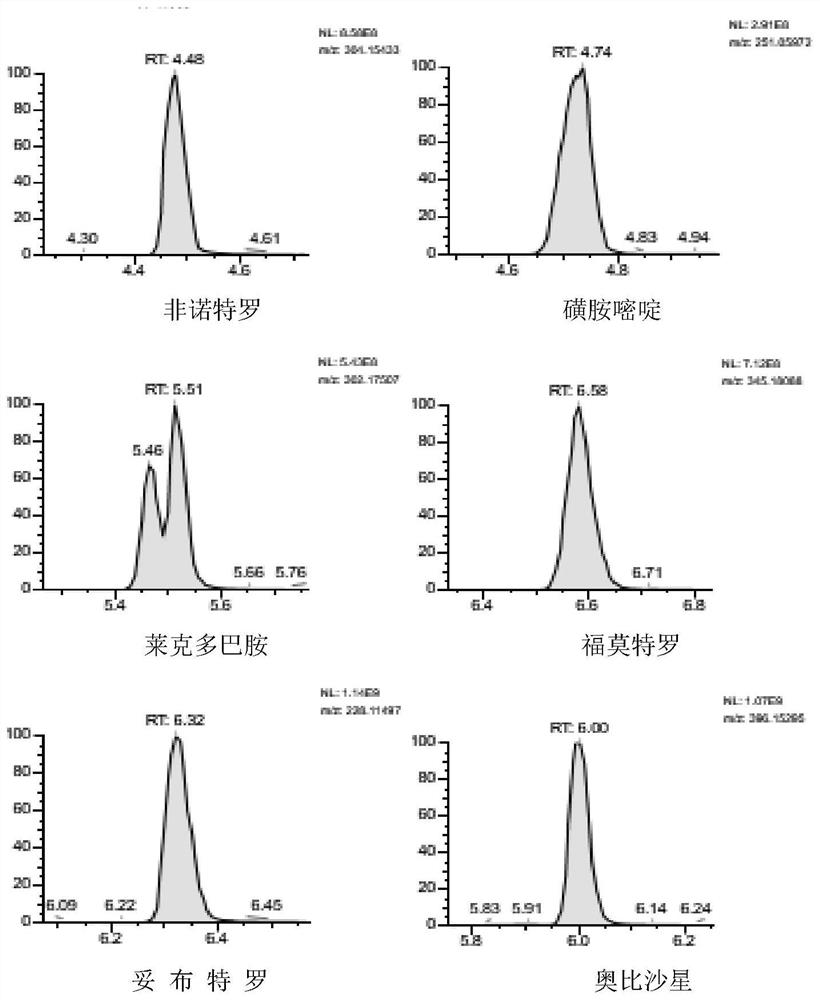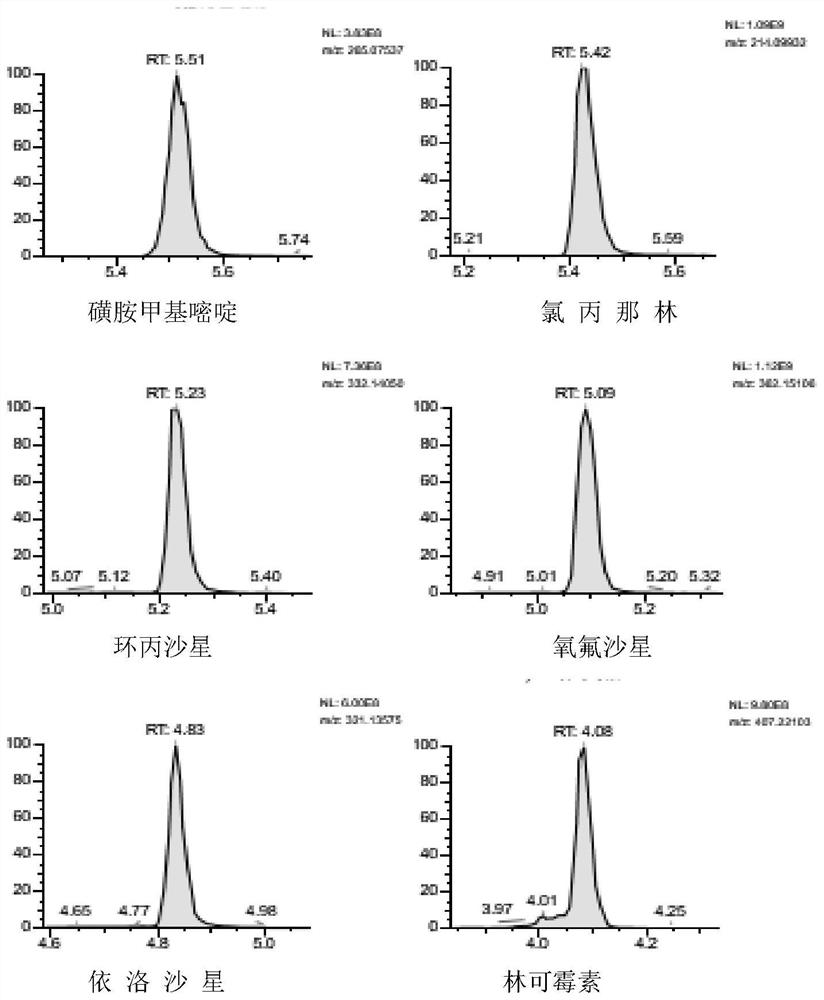Method for detecting veterinary drug residues in fish meat
A detection method and technology for veterinary drug residues are applied in the field of detection of veterinary drug residues in fish meat, and can solve problems such as inability to detect hormones and the like
- Summary
- Abstract
- Description
- Claims
- Application Information
AI Technical Summary
Problems solved by technology
Method used
Image
Examples
Embodiment 1
[0043] Qualitative detection of veterinary drug residues in embodiment 1 fish
[0044] 1) Sample solution preparation:
[0045] Accurately weigh 2.00g (accurate to 0.01g) of homogenized fish sample, transfer it to a 50mL polypropylene (PP) centrifuge tube, slowly add 10mL of 80% volume fraction acetonitrile aqueous solution containing 0.2% formic acid, let it stand for 10min, and then add two Homogenize the ceramic particles, shake vigorously and vortex for 30min (2000r / min) to fully disperse the sample, centrifuge at 9500r / min for 5min, take 5mL of the supernatant, and pass through 6cc of 200mg at 1 drop / s PRiME HLB solid-phase extraction column, collect 4mL of the second half of the effluent and accurately measure 2mL, N 2 Blow dry under the hood, dilute 1mL of the initial mobile phase, pass through a 0.22μm polytetrafluoroethylene filter membrane to obtain the sample solution;
[0046] 2) Preparation of the reference substance solution: Accurately weigh 2 mg of each refe...
Embodiment 2
[0052] Example 2 Qualitative detection of veterinary drug residues in fish meat
[0053] 1) Sample solution preparation:
[0054] Accurately weigh 2.00g (accurate to 0.01g) of homogenized fish sample, transfer it to a 50mL polypropylene (PP) centrifuge tube, slowly add 10mL of 80% volume fraction acetonitrile aqueous solution containing 0.2% formic acid, let it stand for 10min, and then add two Homogenize the ceramic particles, shake vigorously and vortex for 30min (2000r / min) to fully disperse the sample, centrifuge at 9500r / min for 5min, take 5mL of the supernatant, and pass through 6cc of 200mg at 1 drop / s PRiME HLB solid-phase extraction column, collect 4mL of the second half of the effluent and accurately measure 2mL, N 2 Blow dry under the hood, dilute 1mL of the initial mobile phase, pass through a 0.22μm polytetrafluoroethylene filter membrane to obtain the sample solution;
[0055] 2) Preparation of the reference substance solution: Accurately weigh 2 mg of each re...
Embodiment 3
[0060] Quantitative detection of veterinary drug residues in embodiment 3 fish
[0061] a. Preparation of matrix solution: Accurately weigh 2.00g (accurate to 0.01g) homogenized fish sample without veterinary drugs, transfer it to a 50mL polypropylene (PP) centrifuge tube, slowly add 80% volume fraction containing 0.2% formic acid Acetonitrile aqueous solution 10mL, after standing for 10min, add two ceramic homogenizers, shake vigorously and vortex for 30min (2000r / min) to fully disperse the sample, centrifuge at 9500r / min for 5min, take 5mL supernatant, and Drops / s over 6cc 200mg PRiME HLB solid-phase extraction column, collect 4mL of the second half of the effluent and accurately measure 2mL, N 2 Blow dry under the hood, dilute 1mL of initial mobile phase, and pass through a 0.22μm polytetrafluoroethylene filter membrane to obtain matrix solution;
[0062] b. Preparation of reference substance solution: Accurately weigh 2 mg of each reference substance, dilute it with ace...
PUM
 Login to View More
Login to View More Abstract
Description
Claims
Application Information
 Login to View More
Login to View More - R&D
- Intellectual Property
- Life Sciences
- Materials
- Tech Scout
- Unparalleled Data Quality
- Higher Quality Content
- 60% Fewer Hallucinations
Browse by: Latest US Patents, China's latest patents, Technical Efficacy Thesaurus, Application Domain, Technology Topic, Popular Technical Reports.
© 2025 PatSnap. All rights reserved.Legal|Privacy policy|Modern Slavery Act Transparency Statement|Sitemap|About US| Contact US: help@patsnap.com



